定冠词和不定冠词的用法知识讲解
定冠词和不定冠词的用法

定冠词和不定冠词的用法定冠词和不定冠词是英语语法中常见的语法点,不仅在英语学习中经常被用到,也是构建句子意义的重要组成部分。
本文将解析定冠词(the)和不定冠词(a或an)的用法及其区别,并通过举例来更好地理解其应用。
一、定冠词的用法1. 特指某一事物:当所提到的人或物在交际双方都明确的情况下,使用定冠词。
例:The dog barked at the mailman. (这只狗对着邮递员叫。
)2. 特指独一无二的事物:当所提到的人或物在特定上下文中是唯一的,使用定冠词。
例:The moon is shining brightly tonight. (今晚月亮很亮。
)3. 指已经提到过的事物:当前文中已经提到的人或物,再次提及时使用定冠词。
例:I saw a dog in the park. The dog was playing with a ball. (我在公园看到一只狗。
那只狗在和一个球玩。
)4. 特指某种类的人或事物:当特定的人或物属于某一类别时,使用定冠词。
例:The lion is known as the king of the jungle.(狮子被称为丛林之王。
)5. 特指双方都熟悉的人或物:当所提到的人或物是交谈双方都熟悉的,并在上下文中已经提到时使用定冠词。
例:My friend has a new car. The car is red.(我的朋友有一辆新车。
那辆车是红色的。
)二、不定冠词的用法1. 泛指单数事物:当指代的人或物是不确定的、不具体的,数量为一时使用不定冠词。
例:I bought a book from the bookstore.(我从书店买了一本书。
)2. 泛指某一类人或事物:当指代的人或物是属于一类而不具体的,数量为一时使用不定冠词。
例:A lion is a wild animal.(狮子是一种野生动物。
)3. 表达职业:当指代某人的职业时,使用不定冠词。
什么是定冠词和不定冠词

什么是定冠词和不定冠词定冠词和不定冠词是英语中非常重要的语法成分,它们用来限定和修饰名词。
在英语中,定冠词是指具体的事物或人,而不定冠词则表示泛指或不特定的事物或人。
在本文中,我将详细介绍定冠词和不定冠词的用法和区别。
一、定冠词(the)的用法定冠词“the”用于特指,表示特定或已知的人或事物。
具体用法如下:1. 特指独一无二的事物或人例如:The sun rises in the east.(太阳从东方升起)The Eiffel Tower is in Paris.(埃菲尔铁塔在巴黎)2. 特指上下文已提到的事物或人例如:I saw a dog. The dog was very cute.(我看到了一只狗。
这只狗非常可爱。
)She bought a dress yesterday. The dress fits her perfectly.(她昨天买了一件连衣裙。
这件裙子非常合适她。
)3. 特指某一类事物或人例如:The tiger is a fierce animal.(老虎是一种凶猛的动物。
)The bicycle is a popular means of transportation.(自行车是一种受欢迎的交通工具。
)二、不定冠词(a/an)的用法不定冠词“a或an”用于泛指或不特定的事物或人。
具体用法如下:1. 用于单数可数名词前例如:I saw a cat in the garden.(我在花园里看到了一只猫。
)She bought an apple from the market.(她从市场买了一个苹果。
)2. 用于表示一种职业或身份的名词前例如:He is a doctor.(他是一个医生。
)She is an actress.(她是一位女演员。
)3. 用于表示数量或程度的类词前例如:She has a lot of money.(她有很多钱。
)It was an interesting movie.(那是一部有趣的电影。
定冠词和不定冠词的区别及使用场景

定冠词和不定冠词的区别及使用场景定冠词(the)和不定冠词(a/an)在英文中是最基本的冠词。
虽然它们都可以用于指代名词,但它们在用法上有着明显的区别。
本文将详细介绍这两种冠词的区别以及使用场景。
一、定冠词的用法定冠词是指在特指某个人或物时使用的冠词。
它通常用来指代已被提及的事物,或者前文中已经被了解的名词。
定冠词只有一个形式,即“the”。
1. 特指单数名词:当我们需要特指某个单数名词,或者前文中已提及的单数名词时,通常使用定冠词。
例:The pen on the table is mine.(桌子上的笔是我的。
)2. 特指复数名词:当我们需要特指某个复数名词,或者前文中已提及的复数名词时,同样使用定冠词。
例:The books on the shelf are mine.(书架上的书是我的。
)3. 特指某种事物:当我们需要特指某种事物时,例如一家餐馆、电影等,也可以使用定冠词。
例:Let's go to the cinema.(我们去电影院吧。
)二、不定冠词的用法不定冠词是指用于泛指、不特指的名词前的冠词。
不定冠词有两种形式,即“a”和“an”,根据所指的名词的发音来决定使用哪种形式。
1. 泛指单数名词:当我们需要泛指一个单数名词时,通常使用不定冠词“a”。
例:I saw a dog in the park.(我在公园看到一只狗。
)2. 泛指以元音音素开头的单数名词:当我们需要泛指一个以元音音素开头的单数名词时,使用不定冠词“an”。
例:She is an honest person.(她是一个诚实的人。
)三、使用场景及注意事项1. 定冠词用于特指,而不定冠词用于泛指。
因此,在具体场景中,我们需要根据具体情况选择使用哪种冠词。
2. 在复数名词的情况下,通常使用定冠词来特指已提及的复数名词,而不使用不定冠词来进行泛指。
3. 在一些特定短语中,我们习惯性地使用定冠词或不定冠词。
例如,在表示职业、国家或地方名词前,我们通常使用不定冠词。
英语定冠词与不定冠词的用法区别

英语定冠词与不定冠词的用法区别在英语中,冠词是一种重要的语法元素,用于限定名词的范围和确定名词的特定性。
冠词分为定冠词(definite article)和不定冠词(indefinite article)。
定冠词包括"The"和"the",不定冠词则是"A"和"a"。
定冠词和不定冠词在用法上有一些区别,本文将详细介绍这两者的用法及区别。
一、定冠词的用法定冠词用于特指某一个已知的人、事物或概念,表示特指的意义。
1. 特指单数名词:当我们想引用已经提到过或熟知的人或物时,使用定冠词。
例如:- The dog is barking outside the house.(这只狗在屋外叫。
)- She is the girl I met yesterday.(她是我昨天遇见的那个女孩。
)2. 特指复数名词:当我们想引用一组人或物中的某些特定成员时,也可使用定冠词。
例如:- The children are playing in the park.(孩子们在公园里玩耍。
)- The students in my class are very hardworking.(我的班里的学生们非常勤奋。
)3. 特指独一无二的事物:当涉及到某个唯一的事物时,使用定冠词。
例如:- The sun rises in the east.(太阳从东方升起。
)- The Prime Minister delivered an important speech.(首相发表了一次重要讲话。
)二、不定冠词的用法不定冠词用于泛指人或物,表示不确定或未知的意义。
1. 泛指单数名词:当我们提到一个未具体指定的人或物时,使用不定冠词。
例如:- I saw a cat on the roof of the house.(我看到一只猫在房顶上。
) - She wants to be a teacher when she grows up.(她长大后想成为一名教师。
定冠词与不定冠词的区别与应用
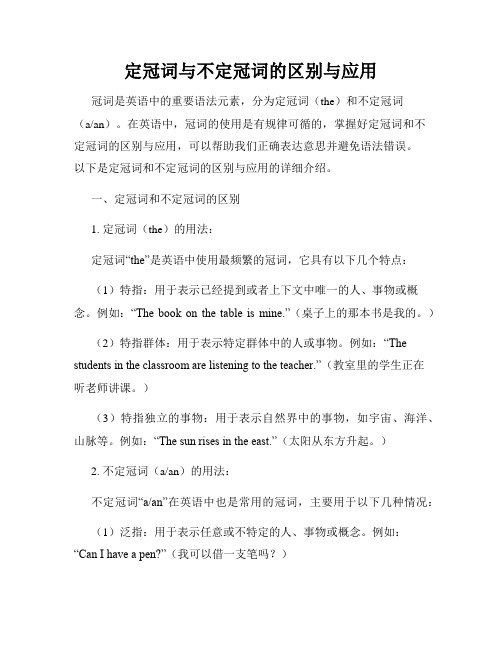
定冠词与不定冠词的区别与应用冠词是英语中的重要语法元素,分为定冠词(the)和不定冠词(a/an)。
在英语中,冠词的使用是有规律可循的,掌握好定冠词和不定冠词的区别与应用,可以帮助我们正确表达意思并避免语法错误。
以下是定冠词和不定冠词的区别与应用的详细介绍。
一、定冠词和不定冠词的区别1. 定冠词(the)的用法:定冠词“the”是英语中使用最频繁的冠词,它具有以下几个特点:(1)特指:用于表示已经提到或者上下文中唯一的人、事物或概念。
例如:“The book on the table is mine.”(桌子上的那本书是我的。
)(2)特指群体:用于表示特定群体中的人或事物。
例如:“The students in the classroom are listening to the teacher.”(教室里的学生正在听老师讲课。
)(3)特指独立的事物:用于表示自然界中的事物,如宇宙、海洋、山脉等。
例如:“The sun rises in the east.”(太阳从东方升起。
)2. 不定冠词(a/an)的用法:不定冠词“a/an”在英语中也是常用的冠词,主要用于以下几种情况:(1)泛指:用于表示任意或不特定的人、事物或概念。
例如:“Can I have a pen?”(我可以借一支笔吗?)(2)表示数量:用于表示“一个”的概念。
例如:“She has a cat.”(她养了一只猫。
)(3)职业、国籍和宗教:用于表示某个职业、国籍或宗教身份。
例如:“He is an engineer.”(他是个工程师。
)二、定冠词和不定冠词的应用1. 定冠词的应用:(1)特指名词:用于特指某个名词,表示已经提到或者上下文中唯一的人、事物或概念。
例如:“She wants to buy the dress.”(她想买那件连衣裙。
)(2)特指群体中的人或事物:用于特指某个群体中的人或事物。
例如:“The students in my class are very hardworking.”(我班的学生都很努力。
不定冠词和定冠词的用法
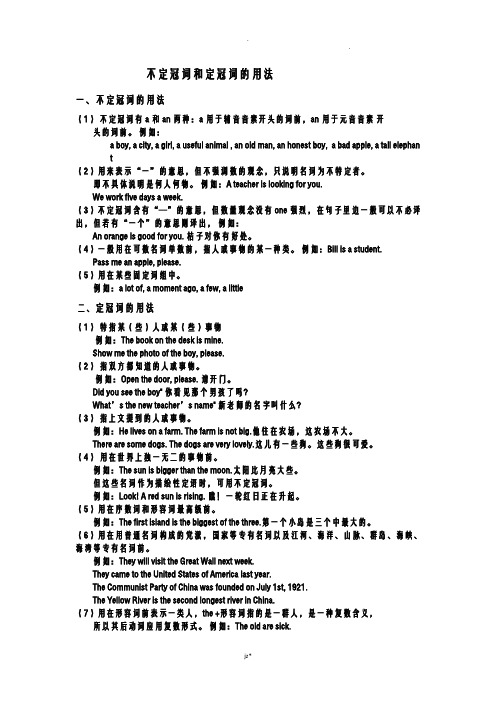
不定冠词和定冠词的用法一、不定冠词的用法(1)不定冠词有a和an两种:a用于辅音音素开头的词前,an用于元音音素开头的词前。
例如:a boy,a city,a girl,a useful animal,an old man,an honest boy,a bad apple,a tall elephant(2)用来表示“一”的意思,但不强调数的观念,只说明名词为不特定者。
即不具体说明是何人何物。
例如:A teacher is looking for you.We work five days a week.(3)不定冠词含有“—”的意思,但数量观念没有one强烈,在句子里边一般可以不必译出,但若有“一个”的意思则译出,例如:An orange is good for you.桔子对你有好处。
(4)一般用在可数名词单数前,指人或事物的某一种类。
例如:Bill is a student.Pass me an apple,please.(5)用在某些固定词组中。
例如:a lot of,a moment ago,a few,a little二、定冠词的用法(1)特指某(些)人或某(些)事物例如:The book on the desk is mine.Show me the photo of the boy,please.(2)指双方都知道的人或事物。
例如:Open the door,please.请开门。
Did you see the boy"你看见那个男孩了吗?What’s the new teacher’s name"新老师的名字叫什么?(3)指上文提到的人或事物。
例如:He lives on a farm.The farm is not big.他住在农场,这农场不大。
There are some dogs.The dogs are very lovely.这儿有一些狗。
这些狗很可爱。
定冠词与不定冠词的使用技巧

定冠词与不定冠词的使用技巧冠词是英语中常用的语法元素之一,它分为定冠词和不定冠词两种。
定冠词包括“the”,而不定冠词则包括“a”和“an”。
正确使用定冠词和不定冠词对于准确表达意思、避免歧义非常重要。
本文将介绍定冠词与不定冠词的基本用法和使用技巧。
一、定冠词的基本用法定冠词“the”一般用在特指的名词前面,用于表示特定的人、事物或群体。
例如:1. The sun rises in the east.(太阳从东方升起。
)2. I saw the movie last night.(昨晚我看了那部电影。
)3. The cat is on the roof.(那只猫在屋顶上。
)此外,定冠词还用于表示独一无二的事物、宇宙事实、历史事件等。
例如:1. The moon revolves around the earth.(月球绕地球运转。
)2. The Great Wall is a famous tourist attraction in China.(长城是中国的著名旅游景点。
)二、不定冠词的基本用法不定冠词“a”用于单数可数名词前面,表示一种不确定、不具体的事物或人。
当紧接的名词以辅音音素开头时,使用“a”;当紧接的名词以元音音素开头时,使用“an”。
例如:1. I saw a dog in the park.(我在公园里看到一只狗。
)2. He is an honest man.(他是一个诚实的人。
)3. She is a university student.(她是一名大学生。
)不定冠词还用于表示职业、宗教、国籍等身份的特指。
例如:1. He wants to be a doctor when he grows up.(他长大后想当一名医生。
)2. She is a Catholic.(她是一个天主教徒。
)三、使用定冠词与不定冠词的技巧1. 指人时,通常用不定冠词“a”或“an”,表示泛指或不具体指代。
定冠词.不定冠词.零冠词的用法详解
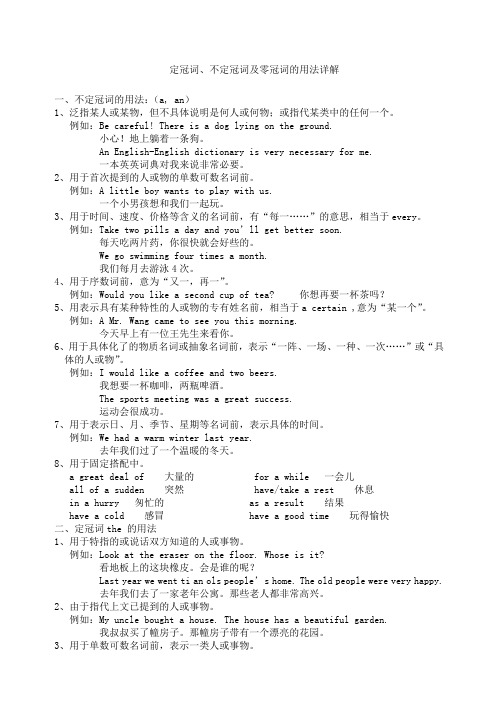
定冠词、不定冠词及零冠词的用法详解一、不定冠词的用法:(a, an)1、泛指某人或某物,但不具体说明是何人或何物;或指代某类中的任何一个。
例如:Be careful! There is a dog lying on the ground.小心!地上躺着一条狗。
An English-English dictionary is very necessary for me.一本英英词典对我来说非常必要。
2、用于首次提到的人或物的单数可数名词前。
例如:A little boy wants to play with us.一个小男孩想和我们一起玩。
3、用于时间、速度、价格等含义的名词前,有“每一……”的意思,相当于every。
例如:Take two pills a day and you’ll get better soon.每天吃两片药,你很快就会好些的。
We go swimming four times a month.我们每月去游泳4次。
4、用于序数词前,意为“又一,再一”。
例如:Would you like a second cup of tea? 你想再要一杯茶吗?5、用表示具有某种特性的人或物的专有姓名前,相当于a certain ,意为“某一个”。
例如:A Mr. Wang came to see you this morning.今天早上有一位王先生来看你。
6、用于具体化了的物质名词或抽象名词前,表示“一阵、一场、一种、一次……”或“具体的人或物”。
例如:I would like a coffee and two beers.我想要一杯咖啡,两瓶啤酒。
The sports meeting was a great success.运动会很成功。
7、用于表示日、月、季节、星期等名词前,表示具体的时间。
例如:We had a warm winter last year.去年我们过了一个温暖的冬天。
定冠词和不定冠词的具体用法说明

定冠词和不定冠词的具体用法说明冠词解释说明:冠词是一种虚词,一般放在名词的前边,用来说明名词的意思。
冠词分为两种,一个是不定冠词,另一个是定冠词。
不定冠词有:a和an两个,a一般用在辅音的前面,举例说明:a man,a book。
an一般用在元音的前面,举例说明:an hour,an interesting book。
定冠词有:the。
下面分别详细讲述冠词的具体用法。
一、定冠词的具体用法。
1、可以用在世界上独一无二的物体前边,举例说明:the sun,the moon2、可以用在由普通名词构成的专有名词前边,举例说明:the Science Museum,the Great Wall3、可以用在山脉、江河、湖海的前面,举例说明:the Pacific Ocean,the Yellow River,the Alps4、可以用在序数词的前面,举例说明:the first,the second5、可以用在形容词最高级前面,举例说明:the tallest,the biggest注意:可以用在副词最高级前面,也可以省略不用。
6、可以用在一些习惯用语当中,举例说明:by the way,the next year,in the morning,in the afternoon,in the evening,on the day7、可以用在杂志、报刊的前面,举例说明:the Times,the Evening Paper8、可以用在一些形容词的前面,表示某一类人,举例说明:the poor,the rich,the living,thedead9、可以用在表示某一家人的前面,举例说明:the Browns 布朗一家10、可以用于表示在某一物体内部的某个地方,举例说明:in the front of the car,在小汽车内部的前面二、不定冠词的具体用法。
1、泛指,表示人或者事物的某一类,举例说明:an apple,a teacher,a boy,a girl2、可以表示数量“1”的意思,但是表示数量的概念没有one这个单词强烈,举例说明:a head,a nose,a mouth3、可以表示某人或者某物,但是不具体说明是某人或者某物,举例说明:a Liu 一个姓刘的人a book三、零冠词的具体用法,即不加冠词的情况。
小学六年级知识点解析定冠词与不定冠词的用法与区别
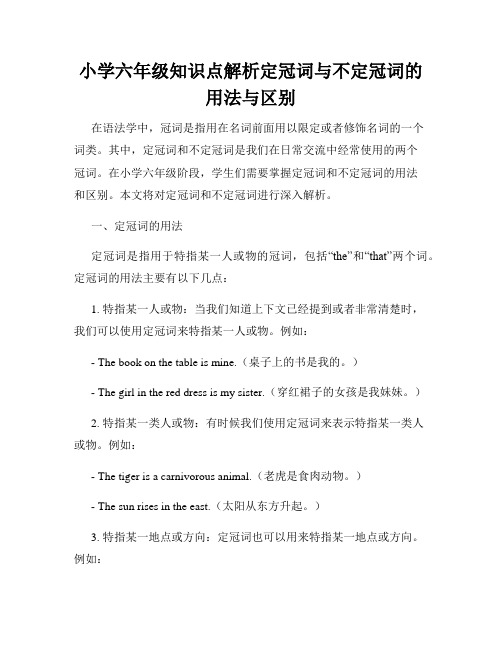
小学六年级知识点解析定冠词与不定冠词的用法与区别在语法学中,冠词是指用在名词前面用以限定或者修饰名词的一个词类。
其中,定冠词和不定冠词是我们在日常交流中经常使用的两个冠词。
在小学六年级阶段,学生们需要掌握定冠词和不定冠词的用法和区别。
本文将对定冠词和不定冠词进行深入解析。
一、定冠词的用法定冠词是指用于特指某一人或物的冠词,包括“the”和“that”两个词。
定冠词的用法主要有以下几点:1. 特指某一人或物:当我们知道上下文已经提到或者非常清楚时,我们可以使用定冠词来特指某一人或物。
例如:- The book on the table is mine.(桌子上的书是我的。
)- The girl in the red dress is my sister.(穿红裙子的女孩是我妹妹。
)2. 特指某一类人或物:有时候我们使用定冠词来表示特指某一类人或物。
例如:- The tiger is a carnivorous animal.(老虎是食肉动物。
)- The sun rises in the east.(太阳从东方升起。
)3. 特指某一地点或方向:定冠词也可以用来特指某一地点或方向。
例如:- The hospital is on the right.(医院在右边。
)- The park is not far from here.(公园离这里不远。
)二、不定冠词的用法不定冠词是指用于泛指、表示不确定或者表示一些人或物的冠词,包括“a”和“an”两个词。
不定冠词的用法主要有以下几点:1. 泛指或表示单数:不定冠词常用于泛指某一人或物,或者表示单数。
例如:- I want to buy a book.(我想买一本书。
)- She is an honest girl.(她是个诚实的女孩。
)2. 表示职业或身份:不定冠词也可以用来表示职业或者身份。
例如:- He wants to be a doctor when he grows up.(他长大后想要当医生。
定冠词和不定冠词的用法口诀
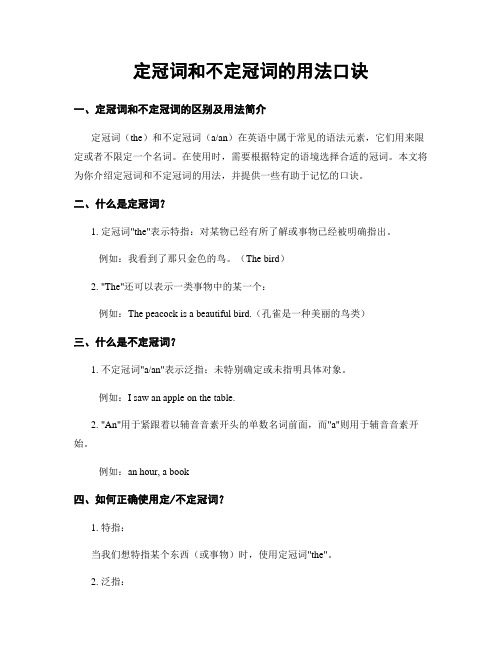
定冠词和不定冠词的用法口诀一、定冠词和不定冠词的区别及用法简介定冠词(the)和不定冠词(a/an)在英语中属于常见的语法元素,它们用来限定或者不限定一个名词。
在使用时,需要根据特定的语境选择合适的冠词。
本文将为你介绍定冠词和不定冠词的用法,并提供一些有助于记忆的口诀。
二、什么是定冠词?1. 定冠词"the"表示特指:对某物已经有所了解或事物已经被明确指出。
例如:我看到了那只金色的鸟。
(The bird)2. "The"还可以表示一类事物中的某一个:例如:The peacock is a beautiful bird.(孔雀是一种美丽的鸟类)三、什么是不定冠词?1. 不定冠词"a/an"表示泛指:未特别确定或未指明具体对象。
例如:I saw an apple on the table.2. "An"用于紧跟着以辅音音素开头的单数名词前面,而"a"则用于辅音音素开始。
例如:an hour, a book四、如何正确使用定/不定冠词?1. 特指:当我们想特指某个东西(或事物)时,使用定冠词"the"。
2. 泛指:当我们想泛指某个东西(或事物)时,使用不定冠词"a/an"。
五、口诀为了更好地记忆和正确运用定冠词和不定冠词,这里提供以下简单的口诀:The不见大山后头巷, a偏爱辅音前肚皮。
以上口诀中的"The不见大山后头巷"是指当名词前出现修饰性带有限定意义的形容词或所有格时,可以省略定冠词。
例如:She went to school.但是如果修饰性形容词前出现两个名次时,必须加上定冠词。
例如:She is holding the red and blue balloons.而"a偏爱辅音前肚皮"则表示当名次以元音字母开头时,就应该用"a"作为不定冠词;当名次以辅音字母开头时,则应该用"an"作为不定冠词。
定冠词和不定冠词的区别与用法
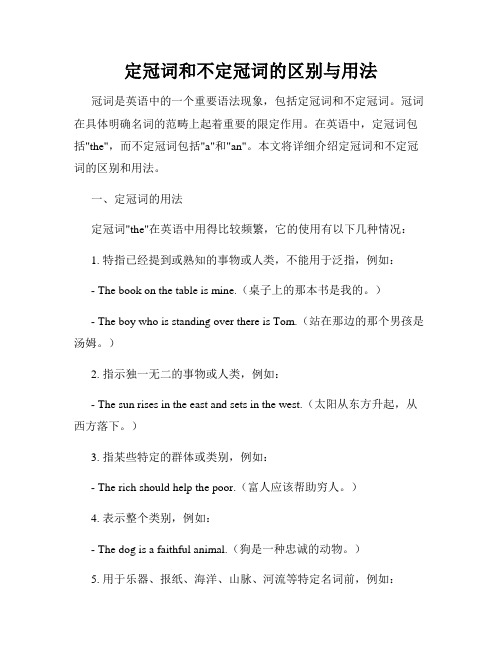
定冠词和不定冠词的区别与用法冠词是英语中的一个重要语法现象,包括定冠词和不定冠词。
冠词在具体明确名词的范畴上起着重要的限定作用。
在英语中,定冠词包括"the",而不定冠词包括"a"和"an"。
本文将详细介绍定冠词和不定冠词的区别和用法。
一、定冠词的用法定冠词"the"在英语中用得比较频繁,它的使用有以下几种情况:1. 特指已经提到或熟知的事物或人类,不能用于泛指,例如:- The book on the table is mine.(桌子上的那本书是我的。
)- The boy who is standing over there is Tom.(站在那边的那个男孩是汤姆。
)2. 指示独一无二的事物或人类,例如:- The sun rises in the east and sets in the west.(太阳从东方升起,从西方落下。
)3. 指某些特定的群体或类别,例如:- The rich should help the poor.(富人应该帮助穷人。
)4. 表示整个类别,例如:- The dog is a faithful animal.(狗是一种忠诚的动物。
)5. 用于乐器、报纸、海洋、山脉、河流等特定名词前,例如:- She plays the piano very well.(她弹钢琴弹得很好。
)- The Himalayas is the highest mountain range in the world.(喜马拉雅山是世界上最高的山脉。
)二、不定冠词的用法不定冠词包括"a"和"an",其主要使用情况如下:1. 用于泛指单数可数名词,例如:- I have a dog.(我有一只狗。
)2. 用于表示职业、信仰、国籍等身份的名词前,例如:- She is an actress.(她是一位女演员。
冠词定冠词与不定冠词的用法

冠词定冠词与不定冠词的用法冠词是英语中一种重要的语法元素,用于修饰名词,帮助确定其特定性或泛指性。
英语中的冠词分为定冠词(definite article)和不定冠词(indefinite article)。
定冠词指的是"the",不定冠词指的是"a"和"an"。
本文将详细介绍冠词的用法,以帮助读者正确使用冠词。
一、不定冠词的用法不定冠词用于泛指某物或某人,表示不特定或未知的名词。
在以下情况中通常使用不定冠词:1. 泛指单数可数名词例如:- I saw a cat in the garden.(我在花园里看到一只猫。
)- She wants to buy a new car.(她想买辆新车。
)2. 表示职业、国籍或宗教信仰例如:- He is a doctor.(他是一名医生。
)- She is an American.(她是一名美国人。
)- He is an atheist.(他是一个无神论者。
)3. 数量不确定的名词前例如:- Can I have an apple?(我可以吃一个苹果吗?)- Would you like a cup of coffee?(你想喝杯咖啡吗?)4. 表示"每"的概念例如:- She goes to the gym three times a week.(她每周去健身房三次。
)- He reads a book a month.(他每月读一本书。
)二、定冠词的用法定冠词用于特指已知的名词,或者表示泛指的名词已经被提及过。
在以下情况中通常使用定冠词:1. 特指单数名词例如:- The cat in the garden is black.(花园里的那只猫是黑色的。
)- Please pass me the salt.(请把盐递给我。
)2. 特指复数名词例如:- The students are studying in the library.(学生们在图书馆学习。
定冠词和不定冠词的搭配和用法
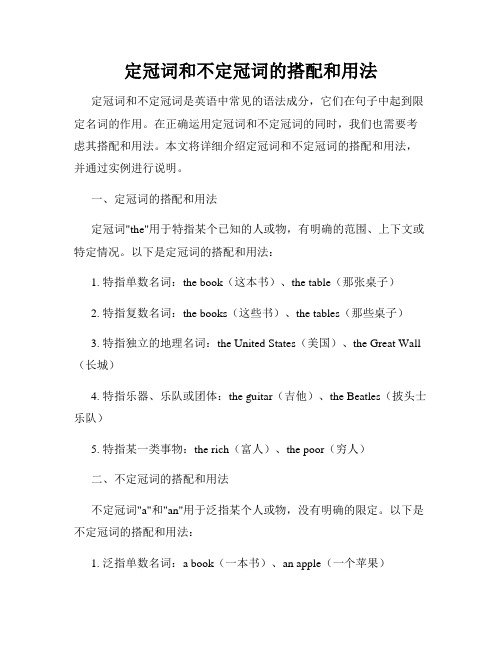
定冠词和不定冠词的搭配和用法定冠词和不定冠词是英语中常见的语法成分,它们在句子中起到限定名词的作用。
在正确运用定冠词和不定冠词的同时,我们也需要考虑其搭配和用法。
本文将详细介绍定冠词和不定冠词的搭配和用法,并通过实例进行说明。
一、定冠词的搭配和用法定冠词"the"用于特指某个已知的人或物,有明确的范围、上下文或特定情况。
以下是定冠词的搭配和用法:1. 特指单数名词:the book(这本书)、the table(那张桌子)2. 特指复数名词:the books(这些书)、the tables(那些桌子)3. 特指独立的地理名词:the United States(美国)、the Great Wall (长城)4. 特指乐器、乐队或团体:the guitar(吉他)、the Beatles(披头士乐队)5. 特指某一类事物:the rich(富人)、the poor(穷人)二、不定冠词的搭配和用法不定冠词"a"和"an"用于泛指某个人或物,没有明确的限定。
以下是不定冠词的搭配和用法:1. 泛指单数名词:a book(一本书)、an apple(一个苹果)2. 泛指以元音音素开头的单数名词:an orange(一个橙子)、an hour(一个小时)3. 表示“每一”的概念:twice a day(每天两次)除了上述搭配和用法外,还有一些特殊情况需要注意:1. 在某些短语中,不定冠词可用于表示“任何一个”的概念:have a look(看一看)、give me a hand(帮我一个忙)。
2. 在某些专有名词和表示职业的名词前,不定冠词可用于表示某一类别或随机选择:a Mr. Smith(一个史密斯先生)、a doctor(一个医生)。
三、比较定冠词和不定冠词的用法定冠词和不定冠词的用法在很多情况下是互补的。
当我们特指某个已知的人或物时,使用定冠词;当我们泛指某个人或物时,使用不定冠词。
定冠词与不定冠词
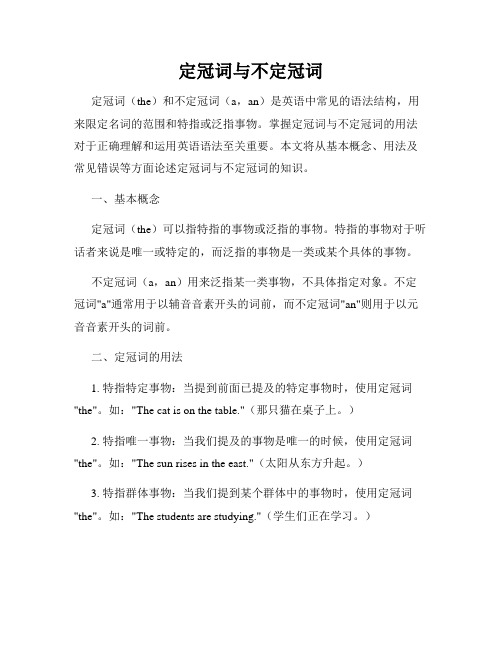
定冠词与不定冠词定冠词(the)和不定冠词(a,an)是英语中常见的语法结构,用来限定名词的范围和特指或泛指事物。
掌握定冠词与不定冠词的用法对于正确理解和运用英语语法至关重要。
本文将从基本概念、用法及常见错误等方面论述定冠词与不定冠词的知识。
一、基本概念定冠词(the)可以指特指的事物或泛指的事物。
特指的事物对于听话者来说是唯一或特定的,而泛指的事物是一类或某个具体的事物。
不定冠词(a,an)用来泛指某一类事物,不具体指定对象。
不定冠词"a"通常用于以辅音音素开头的词前,而不定冠词"an"则用于以元音音素开头的词前。
二、定冠词的用法1. 特指特定事物:当提到前面已提及的特定事物时,使用定冠词"the"。
如:"The cat is on the table."(那只猫在桌子上。
)2. 特指唯一事物:当我们提及的事物是唯一的时候,使用定冠词"the"。
如:"The sun rises in the east."(太阳从东方升起。
)3. 特指群体事物:当我们提到某个群体中的事物时,使用定冠词"the"。
如:"The students are studying."(学生们正在学习。
)4. 指上下文中的特指事物:当我们提到上下文中的特定事物时,使用定冠词"the"。
如:"The book you lent me is very interesting."(你借给我的那本书非常有趣。
)三、不定冠词的用法1. 泛指某一类事物:当我们泛指某一类事物时,使用不定冠词"a"或"an"。
如:"I saw a cat in the garden."(我在花园里看到了一只猫。
定冠词与不定冠词的用法

定冠词与不定冠词的用法冠词是英语中一类特殊的词语,分为定冠词(definite article)和不定冠词(indefinite article)。
定冠词是“the”,而不定冠词则有两种形式,“a”和“an”。
本文将探讨定冠词和不定冠词的用法,帮助读者正确运用它们。
一、定冠词的用法1. 特指某个已知的人或物对象定冠词“the”用于特指已知的人或物对象。
例如:- The book I am reading is very interesting.- I saw the teacher in the hallway.2. 特指上文提到过的人或物对象当文章或对话中已经提到某个人或物对象时,可以用定冠词“the”来特指它们。
例如:- I bought a car yesterday. The car is blue.- She has a cat. The cat is adorable.3. 特指宇宙事实“the”也可用于强调宇宙事实,例如习语中的习惯用法和一些普遍事实。
例如:- The sun rises in the east.- The earth is round.4. 特指某一类事物定冠词也可用于特指某一类事物,而不是具体的个体。
例如:- The tiger is an endangered species.- The rose is a symbol of love.二、不定冠词的用法1. 不特指任何人或物对象不定冠词“a”或“an”用于不特指任何特定的人或物。
例如:- I saw a dog in the park.- She needs an umbrella.2. 表达数量或顺序不定冠词也可用于表达数量或顺序。
例如:- I ate an apple for breakfast.- He is a second-year student.3. 用于职业和宗教身份的描述不定冠词也可用于描述某人的职业或宗教身份。
冠词总结定冠词和不定冠词的用法

冠词总结定冠词和不定冠词的用法冠词总结:定冠词和不定冠词的用法冠词是英语语法中重要的一部分,分为定冠词(definite article)和不定冠词(indefinite article)。
在英语中,冠词的使用非常灵活,但也有一定的规律和约束。
本文将对定冠词和不定冠词的用法进行总结和归纳。
一、定冠词(The)的用法:1. 特指已提及或可明确理解的人、物或概念时使用定冠词:- The boy is playing in the park.(那个男孩正在公园里玩。
)- I saw the movie you recommended.(我看了你推荐的那部电影。
)2. 特指唯一或独一无二的人、物或概念时使用定冠词:- The sun rises in the east.(太阳从东方升起。
)- She is the president of the company.(她是公司的总裁。
)3. 特指整个类别或一类人、物时使用定冠词:- The lion is known as the king of the jungle.(狮子被誉为丛林之王。
)- The rose is a symbol of love.(玫瑰是爱的象征。
)4. 特指上下文中已提及的人、物或概念时使用定冠词:- I bought a car. The car is red.(我买了一辆车。
那辆车是红色的。
) - I have a cat. The cat is sleeping.(我养了一只猫。
那只猫在睡觉。
)5. 特指某个领域或方面时使用定冠词:- The history of China is very long.(中国的历史非常悠久。
)- He is an expert in the field of biology.(他是生物学领域的专家。
)二、不定冠词(A/An)的用法:1. 指称某个不具体或未提及的人、物或概念时使用不定冠词:- I saw a cat on the street.(我在街上看到了一只猫。
定冠词和不定冠词的用法如何正确使用冠词修饰名词

定冠词和不定冠词的用法如何正确使用冠词修饰名词冠词是英语中的一类虚词,包括定冠词和不定冠词。
定冠词包括“the”,表示特指某一人或物;不定冠词包括“a”和“an”,表示泛指或不确定的人或物。
正确使用冠词能够让句子更加准确清晰,下面将从不同的情况和用法来详细介绍定冠词和不定冠词的正确使用。
1. 使用定冠词“the”定冠词“the”用于特指特定的人或物,具体用法如下:a) 当提到特定的事物或人时,如“The book on the table is mine”(桌子上的书是我的);b) 当所指的事物或人在前文中已经提到过,如“I have a dog. The dog is very friendly”(我有一只狗。
这只狗非常友好);c) 当所指的事物或人在上下文中已经明确,如“The sun rises in the east and sets in the west”(太阳从东边升起,从西边落下);d) 用于乐器、婚姻、报纸等特定的名词前,如“I play the piano”(我弹钢琴)。
2. 使用不定冠词“a”和“an”不定冠词“a”和“an”用于泛指或表示不确定的人或物。
具体用法如下:a) 使用“a”来修饰以辅音音素开头的单数可数名词,如“A cat is sleeping on the roof”(一只猫正在屋顶上睡觉);b) 使用“an”来修饰以元音音素开头的单数可数名词,如“There is an apple on the table”(桌子上有一个苹果);c) 使用“a”或“an”来表示泛指,如“I need a pen”(我需要一支笔);d) 使用“a”或“an”来表示职业或宗教信仰,如“She is a teacher”(她是一名老师)。
3. 不使用冠词在某些情况下,名词前不需要加上冠词。
下面是不使用冠词的几种情况:a) 当名词指一般概念、广义事物或抽象名词时,如“Water is essential for life”(水对生命至关重要);b) 当名词用作定语修饰另一个名词时,如“I bought new shoes yesterday”(我昨天买了双新鞋);c) 当表示国籍、宗教信仰、学科、饮食习惯等名词前时,如“She is Chinese”(她是中国人);d) 在表示餐饮的词组中,例如“I had breakfast at home”(我在家吃早餐)。
定冠词和不定冠词的用法

一、定义与分类冠词是用于名词前用以说明该名词含义的虚词(在现代英语中冠词被称为限定词)。
传统语法通常将冠词分为不定冠词和定冠词两类,但现代英语通常将冠词分为不定冠词、定冠词和零冠词三类。
不定冠词有a 和 an两种形式,其中 a 用于辅音音素前,an 用于元音音素前;而定冠词只有the一种形式;现代英语中说的零冠词,其实指的是就是既不用定冠词,也不用不定冠词的情况。
二、不定冠词的主要用法1. 泛指某一类人或物中的任何一个.如:A bird has wings. 鸟有翅膀。
A teacher shou ldn’t talk like that。
教师不应当这样讲话。
2。
笼统指某类中的某一个,但又不具体说明是哪一个。
如:The police caught a thief。
警察抓了一个小偷。
3。
表示数量“一”(但不与 two, three 等相对比)。
如:It took me a year to save up for a new coat. 我用了一年时间才省出钱买一件新大衣。
4。
表示价钱、时间、速度等的“每一"(=per).如:We meet twice a week。
我们每星期碰两次头。
They are sold at two dollars a dozen. 他们的售价是每打两美元。
5. 用于序数词前表示“又一”、“再一".如:We’ll have to do it a second time。
我们得再做一次。
We have put forward a third plan. 他们已提出了第三个方案.6. 在某些物质名词前表示“一杯 / 罐 / 瓶”.如:A coffee / tea / beer, please。
请来杯咖啡 / 茶 / 啤酒。
7. 用于具体化了的抽象名词前。
如:He was a success in business. 他事业成功。
It’s a pleasure to talk with you。
- 1、下载文档前请自行甄别文档内容的完整性,平台不提供额外的编辑、内容补充、找答案等附加服务。
- 2、"仅部分预览"的文档,不可在线预览部分如存在完整性等问题,可反馈申请退款(可完整预览的文档不适用该条件!)。
- 3、如文档侵犯您的权益,请联系客服反馈,我们会尽快为您处理(人工客服工作时间:9:00-18:30)。
----- Oh, I’ve never seen a worse one.
____ How do you like Tom? ____ I’m afraid that no one in my class has a cleverer brain than he.
3. 在叙述中,上文提到过的人或者事物,再次出现时.
e.g. A:I can see a kite.
我看见一只风筝.
B:where is the kite?
这个风筝在那里?
4. 用在姓氏的复数名词前,表示“一家人” e.g. the Blacks 布来克一家
冠词的分类
定冠词的用法
5. 用在宇宙间独一无二的天体名词之前.
e.g.
at night
go to school
6. 在一些固定搭配中
at table by bike
冠
at work
词
go to bed
的
at school
分
at home watch TV
类
7.表示独一无二的职位、职务的名词用作表语、同 位语或补足语时,常见名词有president, chairman, mayor, head, boss, secretary, leader, monitor等。
定冠词的用法
1. 基本用法: “特指”. 特指某(些)人或者某(些)事 物,以便与其他的人或物有所区别.
e.g. The book on the desk is Jim’s. 书桌上的那本书是吉姆的.
The chairs are there.
椅子在那里.
2. 指谈话双方都知道的人或事物.
e.g. Where is the kite? 风筝在哪儿?(双方都知道指的是哪只风筝.) Open the door, please.请把门打开.(双方都知道要打开哪扇门.)
在星期、月份、节日前
4. e.g. on Sunday in August
on Children’s Day
冠 词
请区别:in the spring of 1945
的
(特指,加the )
分
类
不使用冠词的情况
零冠词的用法
5.三餐前不加冠词,但特指须加,有时也可以加a 表示一顿。
e.g. play football/ basketball have supper What do you usually have for lunch? We had a really good dinner.
a pleasure / a success/ a failure
7.用于专有名词前表示类似的一个或某一个. e.g __A______ Mr. Li is asking to see you at the
school gate. 8.否定比较级表达最高级意义时,常用借助于不定 冠词a/ an. a/ an+比较级
定冠词和不定冠词的用法
不定冠词的用法
1. a用在以辅音音素开头的单词前. an用在以元音音素开头的单词前.
e.g. _a_book
_a_n_ egg
_a_ useful book _a_n_ underground room
2. 基本用法: 指人或事物的某一种类
e.g. She is a girl. 她是女孩. This is a desk. 这是一张书桌.
5.表示 “同一”,相当于the same e.g The two boys are of _a_n____ age.
Cotton of __a____ kind was stored together.
6.用于某些物质名词或抽象名词前,表示 “一种、 一类、一份、一场、一阵”.
e.g That is _a___ green tea. They were caught in __a___ heavy rain.
7. 用在某些建筑物和旅馆的名称之前. The Palace Museum The Summer Palace
8. 用在表示乐器的名词之前. e.g. the violin the piano
冠词的分类
定冠词的用法
9. 用在一些习惯用语中 e.g. in the day in the morning / afternoon/ evening the day before tomorrow/ yesterday the next morning / week/ month/ year in the sky/ water/ field/ country in the dark in the rain in the distance in the middle (of) in the end on the whole by the way go to the theatre (cinema) 冠词的分类
eg. He was made monitor yesterday.
8.表示交通工具的名词与by连用.
当bike,car,taxi,bus,train,foot,ship等与介词by连 用, 表示一种交通手段是,不用the。
3. 泛指某人或者某物,但又不具体说明何人何物.
冠
e.g. I can see a kite.
我能看见一只风筝.
词
A boy is in Grade 1. 一个男孩在一年级
的
4. 表示“数Байду номын сангаас”, “有一”“每一”的意思.
分
e.g. We have six classes a day. 我们一天上六节课. 类
不使用冠词的情况
零冠词的用法
1. 名词前有了物主代词、指示代词、不定代词和“S”所有格时。
e.g. Our books those apples Jim’s pen
2. 附复数名词在表示一类人或者事物时。 e.g. They are teachers. 他们是老师。
3. 在专有名词前 e.g. China England
e.g. the sun the sky the moon the earth
6. 用在序数词和形容词最高级,及形容词only, very, same 前.
e.g. I live on the second floor.
我住在二楼
Skating is the best sport in winter. 滑冰是冬天最好的运动
